(July 26, 2014, 7:20 p.m. EDT) –The launch of a United Launch Alliance Delta IV carrying the AFSPC-4 mission was scrubbed today due to a violation of multiple weather criteria.
The launch is rescheduled for Monday, July 28, from Space Launch Complex-37 at Cape Canaveral Air Force Station, Florida to allow for crew rest. The launch time is 6:43 p.m. EDT at the opening of a 65-minute window. The forecast for July 28 shows a 60 percent chance of favorable weather conditions for the launch.
This delay will impact ULA’s next Atlas V launch, the GPS IIF-7 mission. Launch is now targeted for Friday, Aug. 1, from Space Launch Complex 41 at the Cape.
.
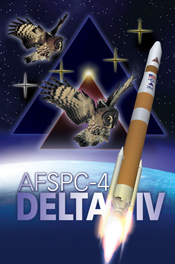
United Launch Alliance (ULA) mission artwork for the Air Force Space Command (AFSPC)-4 payload. The mission includes a pair of Geosynchronous Space Situational Awareness Program (GSSAP) satellites and a single Automated Navigation and Guidance Experiment for Local Space (ANGELS) satellite. Image Credit: ULA
.
On its eighth mission of a marathon 15 planned flights in 2014, United Launch Alliance (ULA) is ready to deliver a pair of Geosynchronous Space Situational Awareness Program (GSSAP) satellites and a single Automated Navigation and Guidance Experiment for Local Space (ANGELS) satellite into a near-geosynchronous orbit of about 22,300 miles (35,900 km), fulfilling the requirements of the Air Force Space Command (AFSPC)-4 mission. Liftoff of the Delta IV Medium+ (4,2) vehicle—numerically designated to identify a 13-foot-diameter (4-meter) Payload Attach Fitting (PAF) and the presence of two solid-fueled Graphite Epoxy Motors (GEM)-60—is scheduled to occur from Space Launch Complex (SLC)-37B at Cape Canaveral Air Force Station, Fla., at 7:03 p.m. EDT on Wednesday, 23 July. According to the 45th Space Wing’s Weekly Planning Forecast, issued Sunday, skies are expected to be partly cloudy throughout Wednesday, with a 60-percent likelihood of rain showers and lightning later in the day.
This launch comes hard on the heels of a highly successful year for ULA, which has seen the return to flight of the Delta II on 2 July, as well as four Atlas V missions—which delivered NASA’s latest Tracking and Data Relay Satellite (TDRS) on 24 January, followed by a Defense Meteorological Satelllite Program (DMSP) on 3 April and the classified NROL-67 and NROL-33 payloads for the National Reconnaissance Office (NRO) on 10 April and 22 May respectively—together with a pair of Delta IV Medium+ (4,2) missions to deliver two Global Positioning System (GPS) Block IIF satellites on 21 February and 17 May. Launched from both Cape Canaveral Air Force Station, Fla., and Vandenberg Air Force Base, Calif., these missions have further bolstered ULA’s reliability credentials. On two occasions in 2014 the company has succeeded in launching two missions within a week of each other.
The Delta IV Medium+ (4,2) is one of the key workhorses of ULA’s fleet, having been utilized for the maiden voyage of the Delta IV, back in November 2002, which launched the commercial Eutelsat W5 communications satellite into geosynchronous orbit. As a rocket, it has the capacity to deliver payloads weighing up to 26,280 pounds (11,920 kg) into low-Earth orbit and up to 14,800 pounds (6,720 kg) into geosynchronous orbit. Since its maiden voyage, it has also boosted the classified NROL-22 and NROL-27 reconnaissance satellites in June 2006 and March 2011 respectively, as well as a pair of Geostationary Operational Environmental Satellites (GOES) for meteorological research in June 2009 and March 2010. More recently, between May 2010 and May 2014, it also placed five members of the current six-strong constellation of GPS Block IIF satellites into medium-Earth orbit. Despite an upper-stage thrust shortfall during the GPS IIF-3 ascent in October 2012, the Delta IV Medium+ (4,2) has never failed to deliver a primary payload into orbit. Wednesday’s flight will be the 12th mission by this particular configuration, as well as the 27th overall launch by a Delta IV and the 85th launch under the auspices of ULA.
The central component of the Medium+ (4,2) is a single Common Booster Core (CBC), which stands 134 feet (41 meters) tall and is equipped with a single RS-68 engine. Fueled with cryogenic oxygen and hydrogen, this powerplant generates 663,000 pounds (300,000 kg) of propulsive yield at the instant of liftoff. It will roar to life at T-5 seconds and undergo a brief period of computer-controlled health checks, ahead of the command to fire the twin GEM-60 strap-on boosters at T-0.01 seconds and the release of the hold-down clamps for launch at T-0.
Following the liftoff command, the vehicle—which stands 206 feet (62 meters) tall, when topped off with its Delta Cryogenic Second Stage (DCSS) and Payload Attach Fitting (PAF)—will be released from the pad surface and commence a fast climb away from SLC-37B. Eight seconds after liftoff, the Delta IV Medium+ (4,2) will execute a combined pitch, yaw, and roll program maneuver to establish itself onto the proper azimuth to deliver the payloads of the AFSPC-4 mission into near-geosynchronous orbit. Powered by its RS-68 engine and twin boosters, it will burst through the sound barrier at T+47 seconds, and, at one minute after launch, it will encounter a period of maximum aerodynamic turbulence on its airframe, known colloquially as “Max Q.”
The GEM-60 boosters—each of which measures 53 feet (16.1 meters) in length—will exhaust their solid fuel at T+94 seconds and will be jettisoned about 100 seconds into the flight, after which the RS-68 will continue to propel the stack toward orbit for a further three minutes. It will be shut down at T+245 seconds and discarded six seconds later, preparatory to the ignition of the DCSS. Equipped by Pratt & Whitney Rocketdyne’s RL-10B2 engine, capable of 24,750 pounds (11,220 kg) of thrust, the DCSS will fire at T+265 seconds. Eleven seconds later, the two-piece (“bisector”) shell of the PAF will be jettisoned. Measuring 38.5 feet (11.7 meters) long, the bullet-like PAF provides the AFSPC-4 payloads with aerodynamic, acoustic, and thermal protection during ascent through the lower atmosphere. Its departure will expose the payloads to the space environment for the first time. How long the RL-10B2 will continue burning after PAF separation remains unknown, for the mission will enter a “media blackout” after this time.
The two GSSAP spacecraft, built by Orbital Sciences Corp., will support U.S. Strategic Command space surveillance operations as a dedicated Space Surveillance Network (SSN) sensor, as well as providing assistance for the Joint Functional Component Command for Space (JFCC-Space) in its task of more accurately tracking and characterizing man-made objects in orbit. When operational, the highly maneuverable satellites will “drift” above and below the geosynchronous Earth orbit “belt” and will employ advanced electro-optical sensors to observe other objects in space. This data is expected to enhance the Air Force’s knowledge of the geosynchronous environment and enable the development of new safety systems, including collision-avoidance mechanisms. The GSSAP satellites will communicate through worldwide Air Force Satellite Control Network (AFSCN) ground stations and from thence to Schriever Air Force Base, near Colorado Springs, Colo.
In March 2014, Gen. William Shelton, head of Air Force Space Command, described the mission as nothing less than a “neighborhood watch” system for U.S. satellites. “GSSAP will produce a significant improvement in space object surveillance, not only for better collision avoidance, but also for detecting threats,” Gen. Shelton told the Air Warfare Symposium in Orlando, Fla., quoted in an article by Space.com. “GSSAP will bolster our ability to discern when adversaries attempt to avoid detection and to discover capabilities they may have which might be harmful to our critical assets at these higher altitudes.” Two of those assets include the Advanced Extremely High Frequency (AEHF) satellites, the most recent of which was launched in September 2013, and the Space-Based Infrared System (SBIRS), whose second “Geosynchronous” element was boosted into orbit in March 2013. “One cheap shot against the AEHF constellation would be devastating,” explained Gen. Shelton. “Similarly, with our Space Based Infrared System, one cheap shot creates a hole in our environment.” Two more GSSAP satellites will ride an Atlas V into orbit in 2016.
Meanwhile, the ANGELS satellite is managed by the Air Force Research Laboratory (AFRL) Space Vehicles Directorate at Kirtland Air Force Base in Albuquerque, N.M., and is designed to examine techniques for providing a clearer picture of the geosynchronous environment surrounding the United States’ critical military satellites. Originally conceived a decade ago, the satellite was developed by Orbital Sciences Corp., under a $29.5 million contract with the AFRL, signed in November 2007. Targeting a one-year operational mission, ANGELS will demonstrate several new technologies, including a Space Situational Awareness (SSA) sensor, which will be evaluated in a limited region close to the DCSS of the Delta IV. “The vehicle will begin experiments approximately 30 miles (50 km) away from the upper stage and cautiously progress over several months to tests within several kilometers,” a Kirtland Air Force Base fact sheet explained. “As part of the research effort, ANGELS will explore increased levels of automation in mission planning and execution to enable more timely, safe and complex operations with a reduced operations footprint. AFRL engineers will maintain positive control of the spacecraft throughout the automation experiments, with ground-commanded authorization to proceed points, ensuring a ‘man-in-the-loop’ throughout the experiment.”
ANGELS is also equipped with a GPS system for geosynchronous and high-performance accelerometers. The latter will employ advanced, NASA-provided algorithms to generate near-continuous navigation solutions and will precisely measure tiny satellite accelerations for enhanced guidance and navigation. An experimental on-board vehicle safety system will also explore methods to reduce the likelihood of collision with other space objects. “The ANGELS program will develop key technologies and capabilities for a broad spectrum of defense and civilian space missions,” explained Dr. Antonio Elias, then serving as Orbital’s Executive Vice-President and General Manager of the Advanced Programs Group, in the November 2007 news release. “Under AFRL’s leadership, this effort will help maintain the United States’ continuing technological and industrial superiority in space.”
Wednesday’s mission also marks the first use of the Evolved Expendable Launch Vehicle (EELV) Secondary Payload Adapter (ESPA) on a Delta IV vehicle. The adapter, which provides an inter-stage “ring” for launching secondary payloads aboard Department of Defense Delta IV and Atlas V flights, is part of an effort to reduce launch costs and achieve minimal impact to the mission. Developed in the 1990s by the AFRL, together with the DoD’s Space Test Program (STP), the adapter ring was designed to accommodate a primary payload weighing up to 15,000 pounds (6,800 kg) and as many as six radially mounted secondary payloads, each weighing up to 400 pounds (180 kg). First trialed on the STP-1 mission in March 2007, launched via an Atlas V, the ESPA housed six military research satellites. More recently, it was employed to support NASA’s Lunar Crater Observation and Sensing Satellite (LCROSS) as a secondary payload alongside the Lunar Reconnaissance Orbiter (LRO), lofted by another Atlas V in June 2009.
.
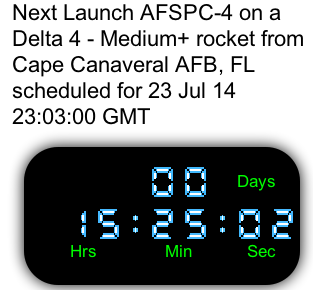
Quelle: AS
.
Update: 24.07.2014
.

.
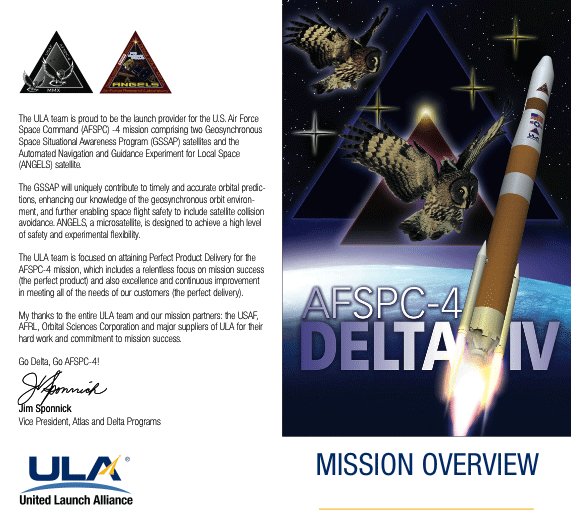
.
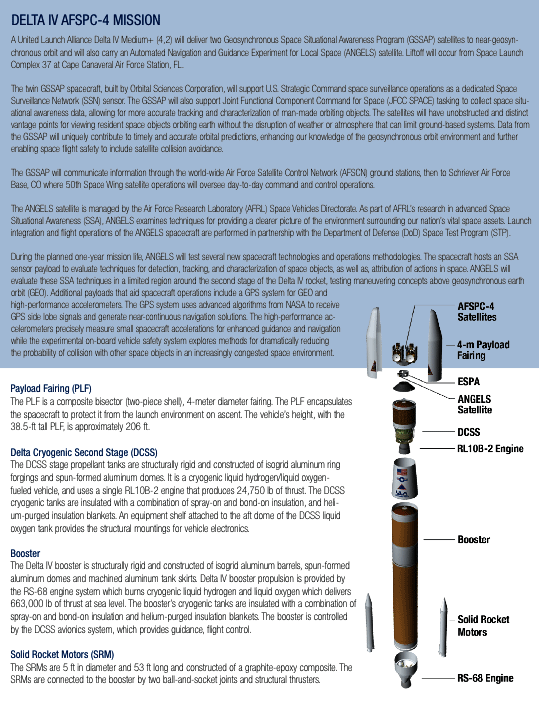
.

Quelle: ulalaunch
-
Update: 21.00 MESZ
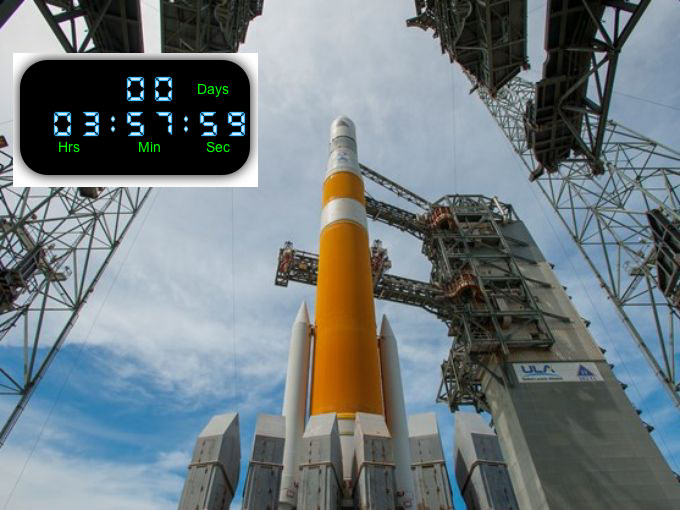
...
.
Update: 25.07.2014
.
Start wegen schlechten Wetter um 24 Stunden verschoben
Mission Live Updates
24Jul2014 21:08:02 EDT
ULA have set next launch attempt for 6:55pm EDT 25 July
After weather scuppered today's launch attempt ULA have elected to try again tomorrow evening at 6:55pm EDT. The weather forecast calls for a 60% chance of violating the Launch Commit Criteria. Once again there will be a 65 minute window.
24Jul2014 19:51:01 EDT
SCRUB
The launch director has just called a scrub for today. The launch teams will now safe the rocket with a view to recycling for another attempt tomorrow.
24Jul2014 19:48:33 EDT
5 weather rules currently violated
The official word is that with 13 minutes left in the window there are five weather rules calling for no go tonight.
24Jul2014 19:46:25 EDT
Storm over the launch complex now
With the storm firmly set over the Cape and rain on the launch pad it looks like tonight will be scrubbed. With the rocket sitting on the launch pad the launch team are going to run down the clock and hope for a last minute reprieve.
.

Quelle: AS
.
Update: 26.07.2014
.
The #AFSPC4 launch is rescheduled for Saturday, July 26. The launch time is 6:51 p.m. EDT at the opening of a 65-minute window. #DeltaIV
Quelle: ulalaunch
.
Update: 20.00 MESZ
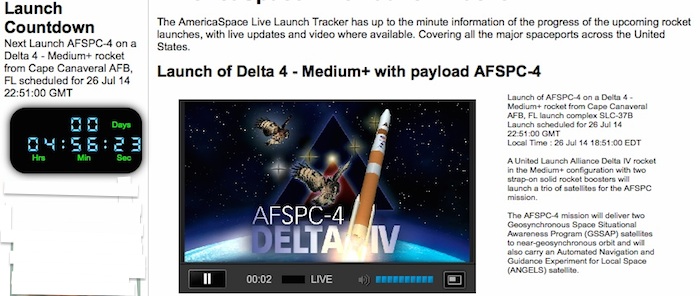
.
Update: 27.07.2014
.
Delta IV to Launch AFSPC-4
Rocket/Payload: A Delta IV Medium+ (4,2) will launch the AFSPC-4 mission for the U.S Air Force.
Date/Site/Launch Time: Monday, July 28, from Space Launch Complex (SLC)-37 at Cape Canaveral Air Force Station, Fla. Launch is planned for 6:43 p.m. EDT.
Viewing the Launch by Webcast: The live webcast will begin at 6:23 p.m. EDT.
Launch Notes: AFSPC-4 will be the 33rd ULA mission for the U.S. Air Force. It will be the eighth of 15 planned missions ULA is slated to launch in 2014, and ULA’s 85th since the company formed in 2006.
Mission Description: The AFSPC-4 mission will deliver two Geosynchronous Space Situational Awareness Program (GSSAP) satellites to near-geosyn¬chronous orbit and will also carry an Automated Navigation and Guidance Experiment for Local Space (ANGELS) satellite.
The twin GSSAP spacecraft will support U.S. Strategic Command space surveillance operations as a dedicated Space Surveillance Network (SSN) sensor. The GSSAP will also support Joint Functional Component Command for Space (JFCC SPACE) tasking to collect space situational awareness data, allowing for more accurate tracking and characterization of man-made orbiting objects.
The ANGELS satellite is managed by the Air Force Research Laboratory (AFRL) Space Vehicles Directorate. As part of AFRL’s research in advanced Space Situational Awareness (SSA), ANGELS examines techniques for providing a clearer picture of the environment surrounding our nation’s vital space assets.
Quelle: ulalaunch
.
Update: 15.30 MESZ
.
ULA to try fifth rocket launch attempt Monday
CAPE CANAVERAL— After four launch attempts in four days, a Delta IV rocket and three military satellites remain right where they started – on the launch pad. But after a day off today (Sunday) to give the launch team a break, United Launch Alliance and the Air Force will take another shot Monday, when the weather is expected to improve a bit. Launch on Monday is targeted for 6:43 p.m., the opening of a 65-minute window at Cape Canaveral Air Force Station.
There's a 60 percent chance of favorable weather – the best odds yet since the mission began trying to get off the ground on Wednesday.
Technical problems scrubbed the first try, but thunderstorms and lightning washed out the next three countdowns on Thursday, Friday and Saturday.
There was some optimism the storms might clear before Saturday's window closed at 7:56 p.m., but a lightning warning never cleared. Several funnel clouds were spotted, and the Titusville area was under a tornado warning for about 30 minutes in the hours leading up to the launch window.
With the day off, the 206-foot Delta IV and its payload were returned to the shelter of a mobile service tower at Launch Complex 37.Atop the rocket are twin satellites that will look out for threats from other spacecraft orbiting more than 22,000 miles up, and a third experimental satellite.
The mission's delay to Monday has pushed back by one day, to Friday, the next launch on the Cape schedule: an Atlas V rocket carrying the seventh in a new series of Global Positioning System satellites. That launch is now planned at 11:23 p.m. Friday, with an 18-minute window.
Quelle: Florida Today
.
Update: 29.07.2014
-
Lift Off von Delta-IV mit AFSPC-4
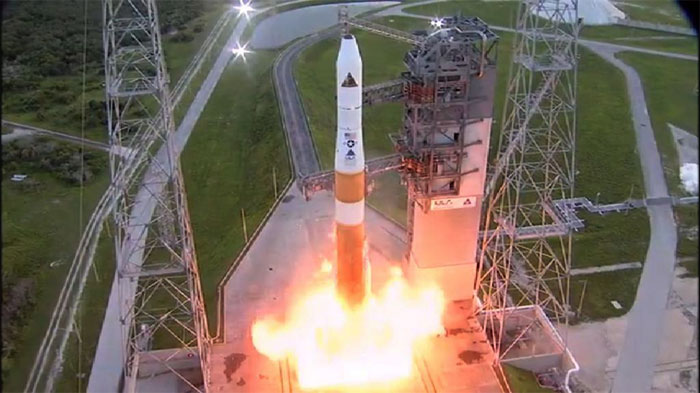
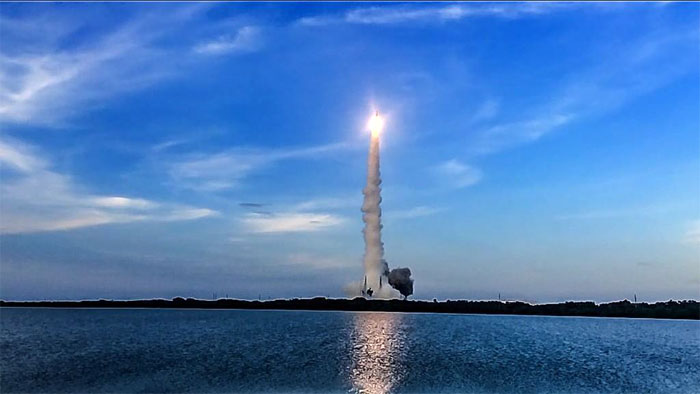
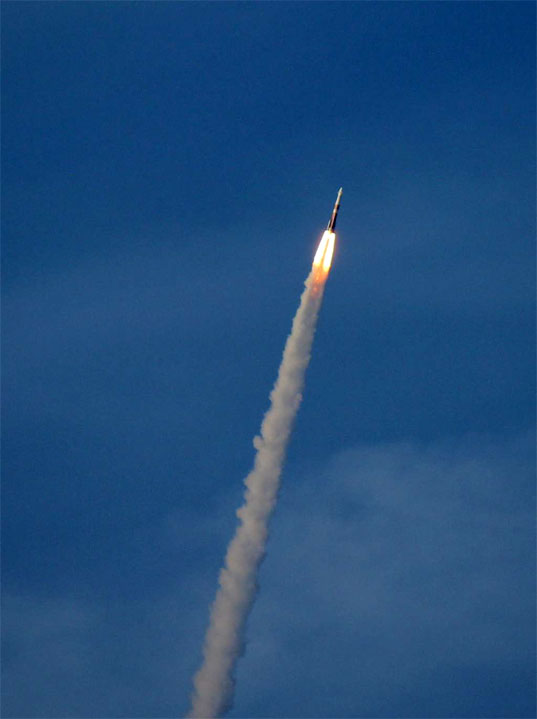


Quelle: ulalaunch
...
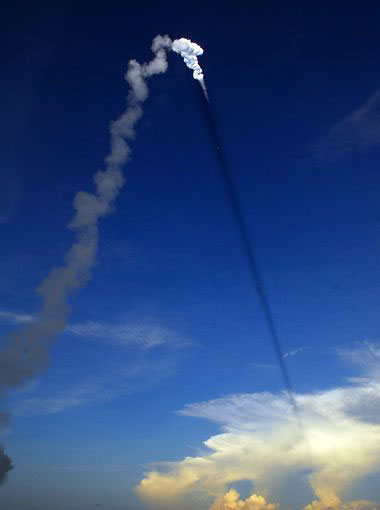
...
Frams von Ulalaunch-Start-Video:
.
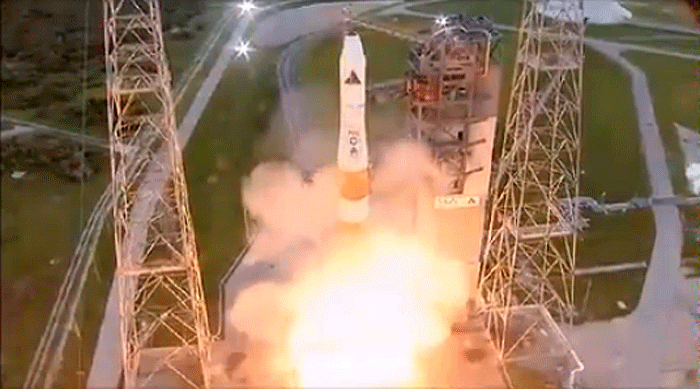
.
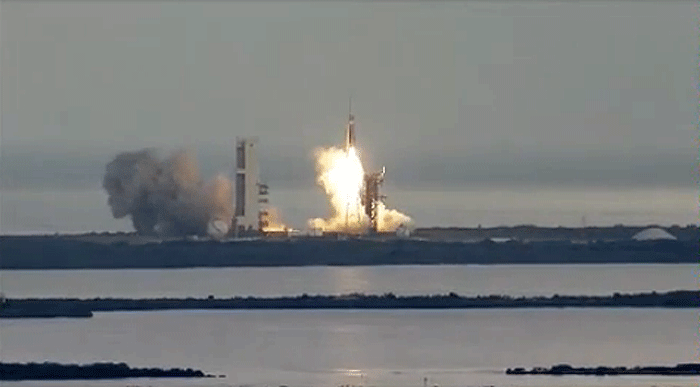
.
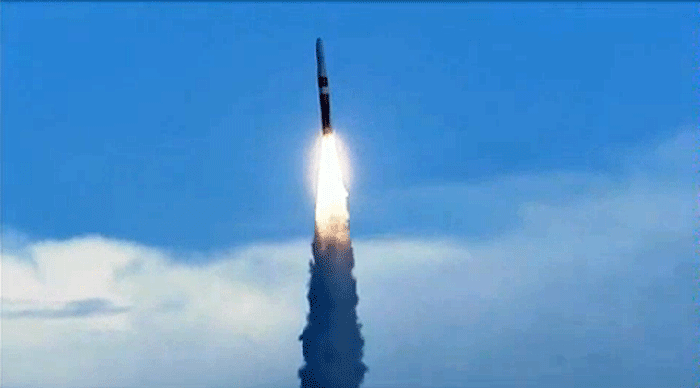
.
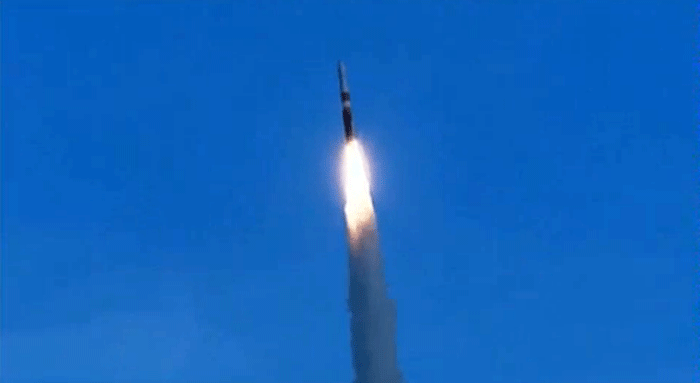
.
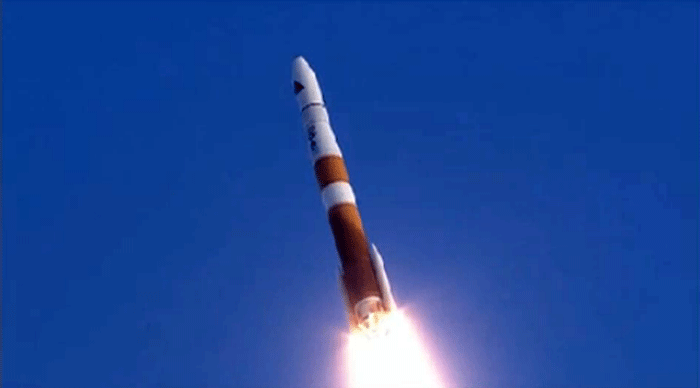
.
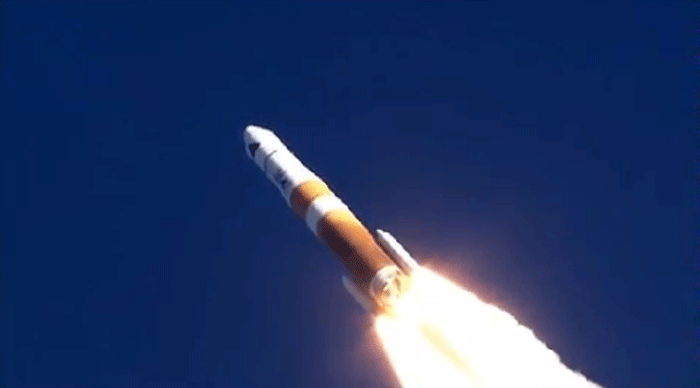
.
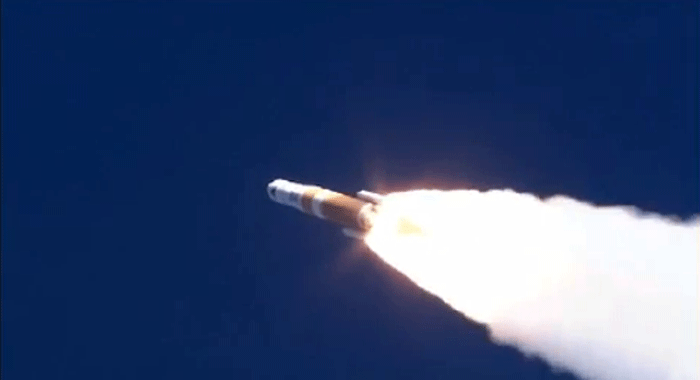
.
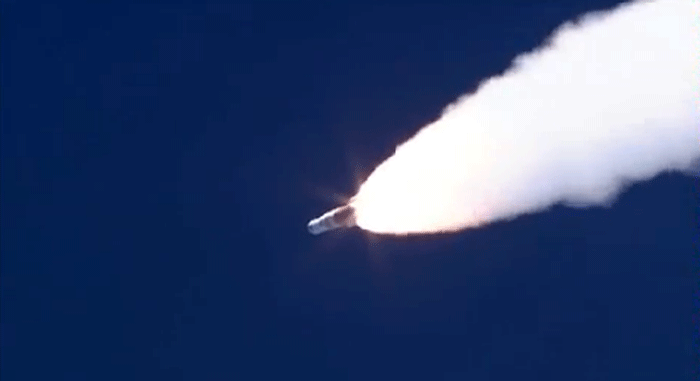
.
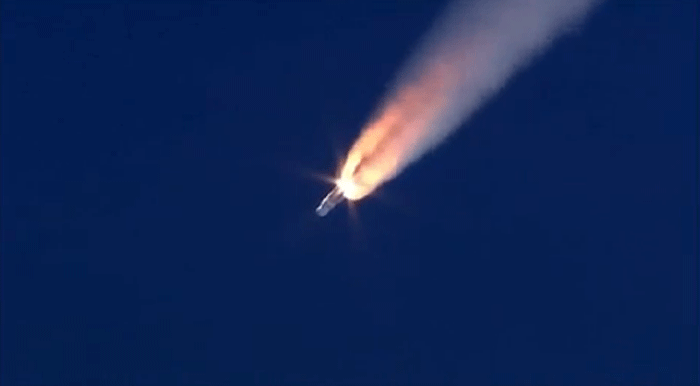
.
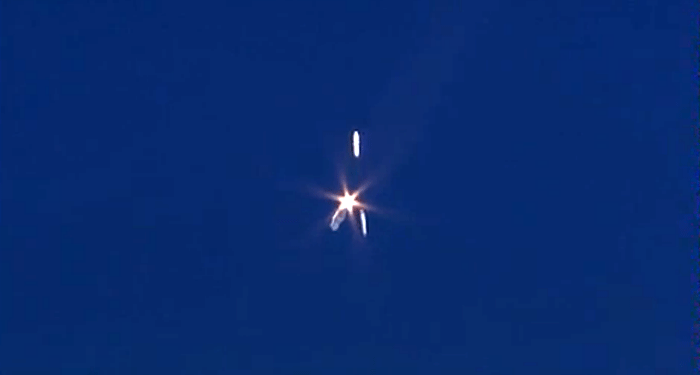
.
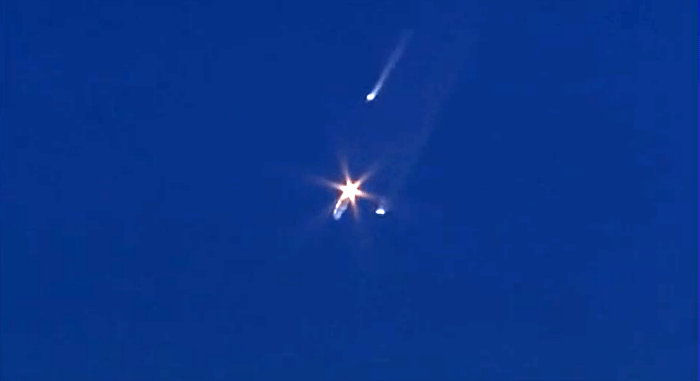
.
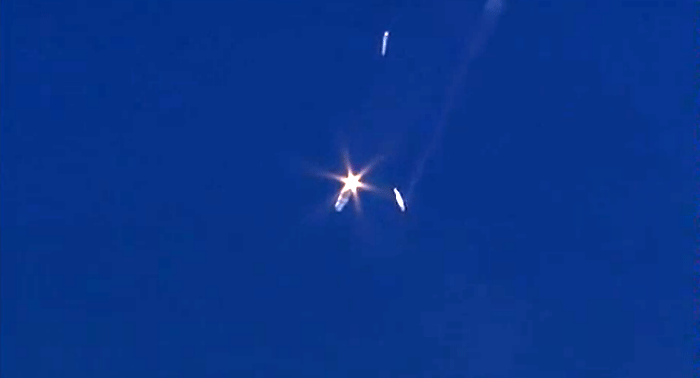
.
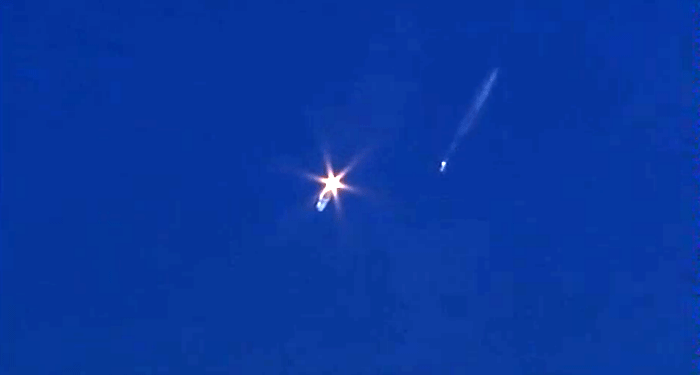
Quelle: ulalaunch
4823 Views
